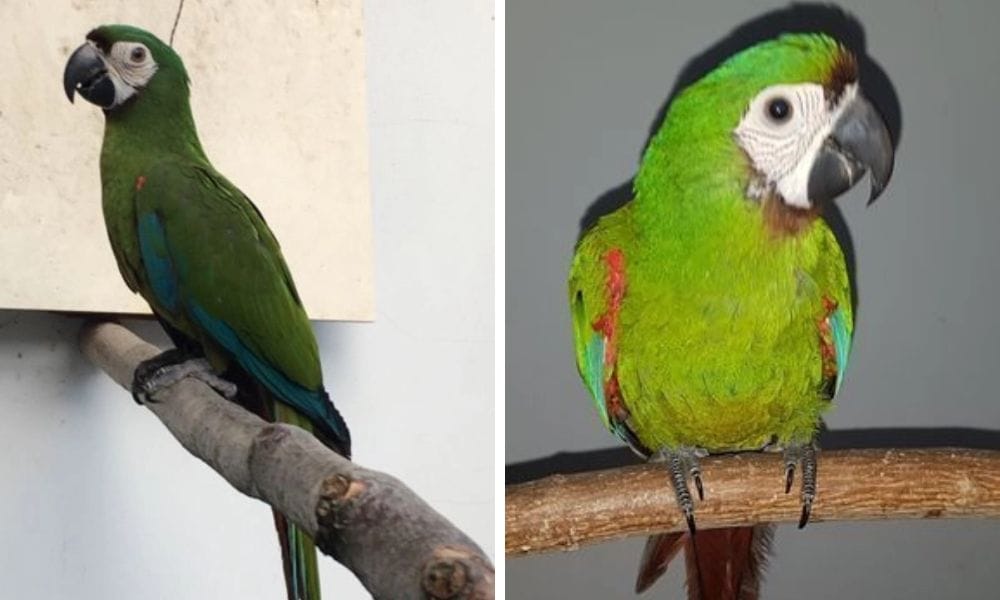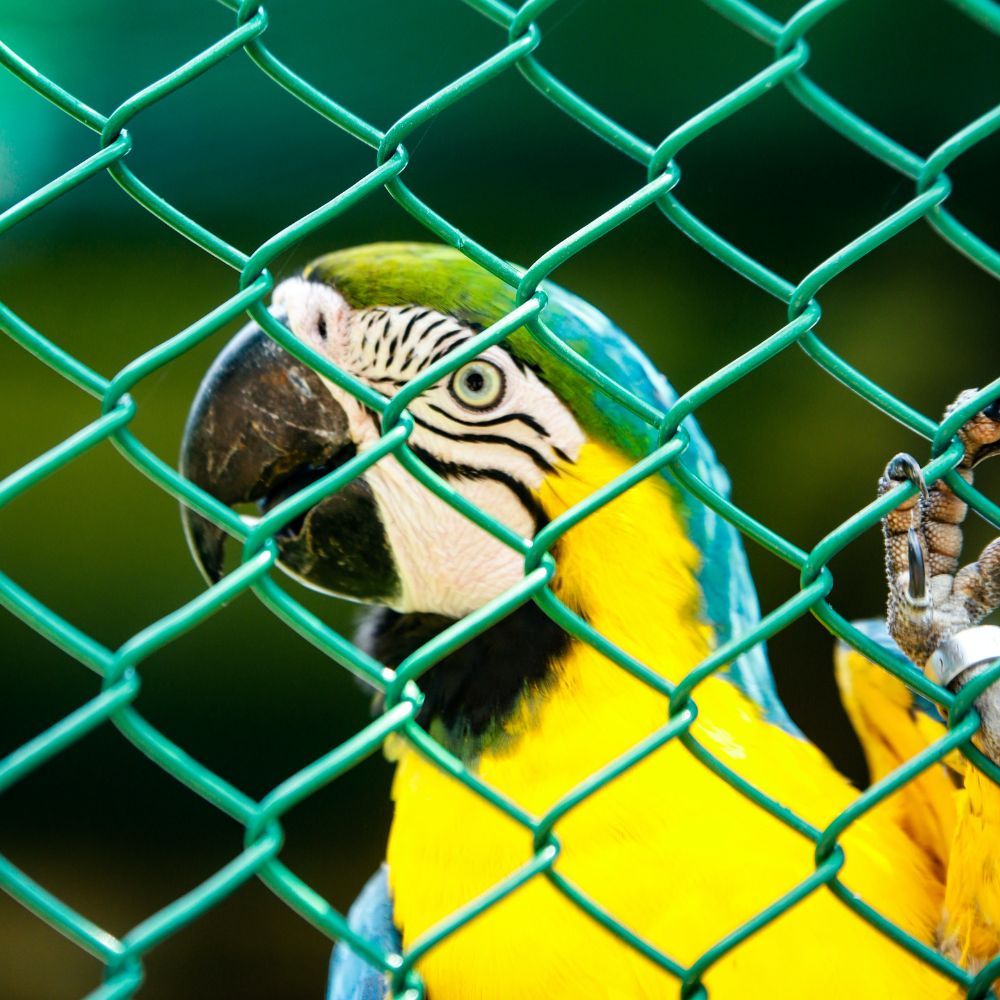Understanding the Chestnut Fronted Macaw: A Vibrant Member of the Psittaciformes Family
Discover all you need to know about one of the most fascinating creatures on our planet -- the Chestnut Fronted Macaw. Enjoy reading!

Key Takeaways:
- Chestnut fronted macaws, also known as severe macaws, are a smaller sized macaw species with distinct plumage and social behaviors.
- These birds are adaptable to both wild habitats and life in captivity, making them popular as pets, especially when hand raised.
- Conservation efforts are important for the chestnut fronted macaw as they face threats from habitat loss and the illegal pet trade.
Introduction to Chestnut Fronted Macaws
The chestnut fronted macaw, scientifically known as Ara severus, is a captivating bird that belongs to the mini macaws group. These parrots are renowned for their striking green plumage, accented with a chestnut brown patch on their foreheads, and a black beak that stands out against their small black feathers. Native to regions of Central America and South America, these birds have adapted to a variety of habitats, showcasing their resilience and versatility.
Physical Characteristics and Chestnut Brown Patch
One of the defining features of the chestnut fronted macaw, compared to other small green macaws, is its unique size and coloring. As a smaller macaw, they are more manageable compared to other macaw species, making them a favored choice for bird enthusiasts. Their tail feathers exhibit a blend of blue and green, which adds to their visual appeal. Despite their smaller stature, their wings are robust, allowing them to fly adeptly through the trees of their native habitats.

Social Behavior and Communication
Chestnut fronted macaws are known for their social nature. As part of the miniature macaws group, they exhibit unique social behaviors. They often travel in small groups, creating a dynamic social structure that is fascinating to observe. Their vocalizations are not just mere sounds; they serve as a means of communication within their flocks. These birds have also earned the reputation of being a “one person bird” due to their tendency to form strong bonds with a single individual when kept as pets.
Speech and Vocalizations
The Chestnut-fronted Macaw is renowned for its loud and clear vocalizations, making it one of the more vocal members of the parrot family. These birds are not just capable of producing a variety of sounds; they are also adept at mimicking human speech and other noises they encounter in their environment. In the wild, their vocalizations serve as a crucial means of communication, helping them stay connected with their flock. They use a range of calls, from screeches to whistles, to express their emotions and needs.
In captivity, Chestnut-fronted Macaws can learn to mimic their owners’ voices, adding a delightful interactive element to their companionship. However, potential owners should be prepared for their loud calls, which can be quite piercing. Understanding and appreciating their vocal nature is key to fostering a harmonious relationship with these vibrant birds.
Diet and Feeding Habits
In the wild, the diet of chestnut fronted macaws consists mainly of seeds, fruits, and nuts. They are also known to visit clay licks, which are mineral-rich deposits that help them detoxify their system and supplement their diet with essential nutrients. When in captivity, a balanced diet can be maintained with a high-quality parrot mix, supplemented with fresh fruits and vegetables.
Exercise and Socialization
Chestnut-fronted Macaws are highly active and social birds that thrive on regular exercise and interaction. In their natural habitat, these macaws fly long distances in search of food and engage in social activities with their flock. To replicate this in captivity, it’s essential to provide them with a spacious aviary or cage that allows for ample movement and flight.
Regular socialization is equally important. Chestnut-fronted Macaws form strong bonds with their human caregivers and require daily interaction to stay mentally stimulated and emotionally satisfied. This can include playtime, training sessions, and simply spending time together. Without sufficient exercise and socialization, these birds may develop behavioral issues such as screaming and feather plucking. Ensuring they have plenty of toys and activities can help keep them engaged and happy.
Health and Lifespan of Chestnut Fronted Macaws
When it comes to the health and longevity of the Chestnut Fronted Macaw, or Ara severa, there’s much to be optimistic about. While these mini macaws are generally robust, they can be susceptible to diseases like macaw wasting disease. These mini macaws are known for their robustness, often living up to 30 years or more with proper care. A key factor in their health is their diet, which consists of a variety of fruits, nuts, seeds, and vegetables. Ensuring they receive a balanced diet that mimics their natural intake is crucial for maintaining their well-being and preventing common health issues.
In captivity, the lifespan of a Chestnut Fronted Macaw can be significantly extended with regular veterinary check-ups and a well-maintained living environment. These birds are social creatures and require mental stimulation to stay healthy, which means plenty of toys and interaction with their human companions. It’s also important to note that hand raised severe macaws, which are often more accustomed to human interaction, may exhibit different health needs than their wild counterparts, emphasizing the importance of personalized care.
The Role of Chestnut Fronted Macaws in Ecosystems
Chestnut Fronted Macaws play a pivotal role in their native ecosystems. As they feast on a variety of fruits, these birds are excellent seed dispersers, aiding in the propagation of many plant species. This not only helps maintain the biodiversity of their habitats but also ensures the continuation of the delicate balance within these ecosystems. Their diet consists largely of fruits that are seasonally available, making them important players in the natural cycle of growth and regeneration.
Moreover, the presence of Chestnut Fronted Macaws can be an indicator of the health of their environment. These birds require large, mature trees for nesting and an abundant supply of food sources, which are only available in thriving forests. By monitoring the populations of species like the Ara severa, conservationists can gain valuable insights into the state of tropical ecosystems and the effectiveness of current environmental protection efforts. Their vibrant presence is a testament to the richness and complexity of the habitats they occupy.
Reproduction and Nesting
The breeding habits of chestnut fronted macaws are quite intriguing. They typically nest in the cavities of trees, where the female incubates the eggs. During this period, the male plays a supportive role by providing food and excellent camouflage to protect the nest from predators like boa constrictors.

Habitat and Distribution
These macaws are native to a range of environments, from the dense forests of Central America to the woodlands of South America. The pet Ara severus, or chestnut fronted macaw, is popular in aviculture due to its adaptability. Their adaptability to different habitats is a testament to their resilience. However, deforestation and habitat destruction pose significant threats to their survival in the wild.
Chestnut Fronted Macaws in Captivity
When it comes to life in captivity, chestnut fronted macaws can thrive if provided with a spacious cage and a stimulating environment. Hand raised severe macaws are particularly known for their friendly disposition and ability to form strong bonds with their human caregivers. It's crucial to provide them with plenty of opportunities to exercise and play to maintain their physical and mental health. If you are looking for a cage for your macaw you can find our list of top 3 cages for macaw below.

Care and Adoption
Adopting a Chestnut-fronted Macaw is a rewarding experience, but it comes with significant responsibilities. These birds require a large aviary or cage that provides enough space for them to fly and exercise. A balanced diet is crucial for their health, consisting of a variety of fruits, vegetables, and high-quality pellets. Fresh water should always be available.
Social interaction is a cornerstone of their well-being. Prospective owners should be prepared to spend considerable time engaging with their macaw, offering companionship and mental stimulation. It’s also important to research and comply with local laws and regulations regarding the ownership of exotic birds, as these can vary widely.
Before bringing a Chestnut-fronted Macaw into your home, ensure you are fully prepared to meet their needs and provide a loving, stable environment. These birds can live for several decades, so adopting one is a long-term commitment.
Conservation Status
The chestnut fronted macaw faces challenges due to habitat loss and the illegal pet trade. Conservation efforts are essential to ensure the survival of these birds in their natural habitats. By supporting sustainable practices and responsible pet ownership, we can contribute to the protection of these vibrant creatures.
Interaction with Other Birds
In the wild, chestnut fronted macaws may interact with other birds, but they tend to stick to their own kind when it comes to forming flocks. In captivity, they can coexist with other birds if introduced properly, but their social dynamics should be monitored to prevent any potential conflicts.
Comparison to Other Macaws
The Chestnut-fronted Macaw, one of the eight extant species of macaws, stands out with its distinctive chestnut brown patch on its forehead. Compared to other macaw species, such as the large macaws, the Chestnut-fronted Macaw is considered a small to medium-sized bird, reaching lengths of up to 45 cm (18 in). This makes them more manageable for those who may find the larger macaws too overwhelming.
Their playful and social personalities make them a popular choice among bird enthusiasts. However, they do require regular exercise and socialization to prevent boredom and behavioral issues. While they can be loud and demanding, their ability to form strong bonds with their owners and their engaging nature make them a unique and rewarding pet for those with the experience and dedication to care for them properly.
In summary, the Chestnut-fronted Macaw offers a blend of manageable size, vibrant personality, and striking appearance, making them a standout among the macaw species.
Summary
The chestnut fronted macaw, or Ara severus, is a smaller macaw species with a distinctive appearance and sociable nature. These birds are adaptable, able to live in various habitats, and can make excellent pets when hand raised. Their diet in the wild includes seeds, fruits, and nuts, and they are known for visiting clay licks. Reproduction involves nesting in tree cavities, with the female incubating the eggs. Despite facing threats from habitat loss and the illegal pet trade, these macaws can thrive in captivity with proper care. Conservation efforts are vital for their continued survival.

FAQ Section
Q: How long do chestnut fronted macaws live? A: Chestnut fronted macaws can live for 30 to 40 years in captivity with proper care, although their lifespan in the wild may be shorter due to natural predators and environmental factors.
Q: Can chestnut fronted macaws talk? A: Yes, chestnut fronted macaws are capable of mimicking human speech, although their vocabulary may not be as extensive as some of the larger macaw species.
Q: Are chestnut fronted macaws endangered? A: Chestnut fronted macaws are currently listed as Least Concern by the IUCN Red List, but their populations are declining due to habitat destruction and the pet trade, emphasizing the need for conservation efforts.

